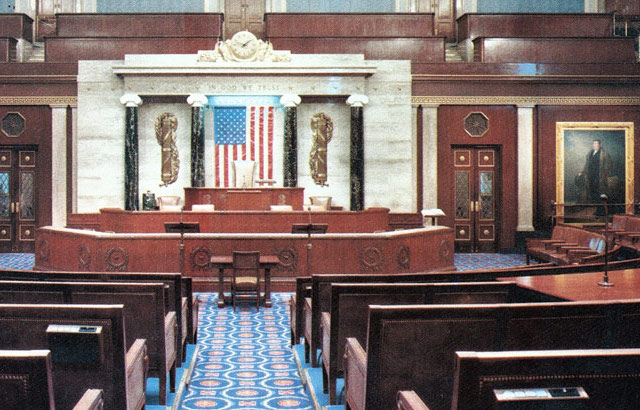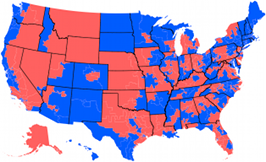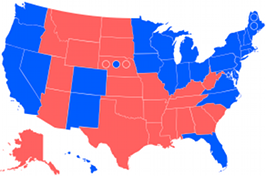NPR had a poll done of what they call the 60 most competitive House seats held by Democrathttp://unlikelyvoter.com/wp-admin/options-media.phps, as well as the 10 most competitive held by Republicans. However the poll wasn’t done seat by seat, but rather in three groups: The top 30 of the Democrats, the bottom 30 of the Democrats, and the 10 Republicans.
Let’s see just how far each group is swinging compared with 2008, and try to guess what that means for the country.
Greenberg Quinlan Rosner and Public Opinion Strategies conducted the poll for NPR. The Margin of Error for each tier of seats held by Democrats is 4.6. The Margin of Error for the seats held by Republicans is 5.6.
I’m going to take each of the three tiers separately, and see what they project. First, we’ll look at Republican Tier: the 10 seats held by Republicans which NPR says are most competitive. They are CA-03, CA-44, DE-AL, FL-25, HI-01, IL-10, LA-02, MN-06, PA-06, and PA-15.
According to figures I have from US Election Atlas, in 2008 the two party vote totals were 1,316,888 for Democrats, 1,424,691 for Republicans, or a 52-48 two party vote, with a 4 point Republican advantage. According to the NPR poll, Republicans are ahead 49-37. Subtracting down to a two party vote, that’s a 57-43 for a 14 point Republican advantage. That’s a 10 point swing for Republicans.
Even if we subtract HI-01 from the 2008 results, since it was a big victory for Democrats, it’s 1,162,680 for Democrats, and 1,386,576 for Republicans. Two party split becomes 46-54, a 8 point Republican gain, and a 4 point swing. Much smaller but, then again, I’m not sure it’s fair to subtract HI-01 when that district was included in the poll itself. But I know the question would be asked, so I asked it.
Now to turn to the tier of the 30 most competitive seats held by Democrats, according to NPR. These 30 are AL-02, AR-01, AR-02, AZ-08, CO-04, FL-08, FL-24, ID-01, IN-08, KS-03, LA-03, MD-01, MI-01, MI-07, MS-01, NH-01, NH-02, NJ-03, NM-02, NY-24, NY-29, ND-AL, OH-01, OH-15, PA-07, TN-06, TN-08, VA-02, VA-05, WA-03.
Not including LA-03 and AR-01 which were uncontested per my source, the two party popular vote was 4,931,172 to 3,492,016, or 59%-41%, or an 18 point advantage for Democrats. However in the poll, the Democrats are behind 31-44, or boiling it to a two way vote, 41-59, for a mind-boggling 36 point swing toward the Republicans from 2008.
Finally we turn to the third tier, the second 30 most competitive seats held by Democrats, per NPR. These are AZ-01, AZ-05, CA-11, CO-03, FL-02, IL-14, IN-09, IA-03, MO-04, NV-03, NM-01, NY-01, NY-13, NY-19, NY-23, NY-25, NC-08, OH-16, OH-18, PA-03, PA-08, PA-10, PA-11, PA-12, SC-05, TX-17, VA-09, WV-01, WI-07, WI-08.
Of course NY-23 was won by a Republican in 2008, but the two-party vote in 2008 for these seats was 5,061,886 D – 3,517,899 R, or a 59-41 split. Again, this is a D+18 result. For this second tier, the poll shows 38-45, or a 42-58 two party split. A 17 point Republican advantage, one less than that first tier, means a 35 point swing for the Republican party.
For some perspective, if we had a 35 point swing nationwide, the House Swingometer says Republicans would get a 104 seat gain over 2008, and take a 282-153 House majority..
Now that’s what the poll is effectively saying. Do I believe it? I don’t entirely, no. I’m pretty skeptical of the ability to get a good random sample from 10 or 30 discontiguous House districts, as this poll would have to have done for the Republican tier and for both tiers held by Democrats.
But unless Greenberg Quinlan Rosner is in the habit of putting its name on polls which are systematically skewed toward Republicans, this poll does suggest a partisan wave is coming, not an anti-incumbency wave.



 House of Representatives Swingometer
House of Representatives Swingometer Electoral College Swingometer
Electoral College Swingometer
Do you mean the Dem margin of error is “4.6”? Or do you really mean “46”?!
Good catch. Yes, 4.6. :-)
Neil –
Here is a public Google spreadsheet that might help you out. We are tracking competitive conservative House races. Most of the districts you mention line up with what we are seeing…
http://bit.ly/dm728I
There isnt an IA-08, is that perhaps IN-08? I’m tracking 115 races of weak GOP (5) and Dems (110). All NPR choices are on my list, but some in their first tier seem to be odd choices like AZ-08 and NJ3. I hope they are right, but not sure how the choices were made.
Correct, I typoed it.